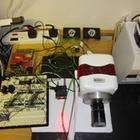Molecular Switch Could Lead to Cheaper Biofuels
July 16, 2024 10:54 am | by Skip Derra | CommentsOne of the biggest tradeoffs in renewable biofuels pertains to the raw materials of the process. The most common renewable raw materials for biofuel production include wood waste and straw. But obtaining the cellulose from these sources is difficult to do because of its complex structure.
Wood-eating Gribbles Could Show How to Convert Waste to Biofuel
June 26, 2024 1:42 pm | by Skip Derra | CommentsThe gribble, a wood-boring marine isopod long has been considered nothing more than a nautical nuisance. Its specialty is boring its way into the wooden hulls of ships, turning seafaring into an even more perilous undertaking. But new research that shows how the gribble digests wood could hold a key to the production of carbon-neutral fuels from waste.
HIV Trial to Create New Immune Systems
June 18, 2024 10:05 am | by Cynthia Fox | CommentsPeople living with HIV will be treated with genetically engineered stem cells next month by the team of Nobel Prize-winning immunologist David Baltimore, PhD, Robert Andrews Millikan Professor of Biology, California Institute of Technology. The goal: to create, in patients, new immune systems resistant to HIV.
The Collaborative RNA Dream
June 12, 2024 2:28 pm | by Christina Smith | CommentsYesterday, the RNA Institute at New York’s State University at Albany opened its doors to reveal a space that has been four years in the making: a newly expanded facility totaling 25,000 square feet, equipped with millions of dollars of laboratory equipment and constructed with a novel goal in mind – to foster collaboration on RNA research among researchers across the nation.
The Fire of Life
June 7, 2024 11:08 am | by Skip Derra | CommentsForest fires are powerful, highly destructive events that while being life altering also have come to be appreciated for their clearing effects, from which explosive new forest growth evolves. But why does the forest respond in this way to such a dramatic event, and what triggers the natural growth that follows? Is there some sort of communication among plants to signal that the coast is clear for growth?
Multi-Parametric Electrophysiological Imaging of the Mammalian Heart in vivo
June 6, 2024 11:05 am | by James Joubert, application scientist, Photometrics | Photometrics | CommentsCardiac arrhythmia is one of the most common diseases encountered in clinical cardiology. High-speed electrophysiological imaging using fluorescent probes has yielded tremendous insights into the basic mechanisms of arrhythmias and the effects of anti-arrhythmic drugs. However, optical mapping, as it is known to the cardiac research community, has remained relegated to the isolated (i.e. explanted) heart.
FDA-approved Stem Cell Trial Dramatically Slows ALS
May 30, 2024 1:34 pm | by Cynthia Fox | CommentsFor two years, stem cells slowed the progression of Lou Gehrig’s disease, a condition with a two-to-five year survival rate, in a group of patients. “We have now extended the lives of patients with Amyotrophic Lateral Sclerosis (ALS) and significantly improved the quality of their lives. They are now living high-quality lives with this disease,” says Neuralstem CEO Richard Garr.
Crowd-Sourcing the Clones: A New Kind of Peer Review?
May 30, 2024 1:34 pm | by Cynthia Fox | CommentsEditors of PubPeer were used to getting only about 400 unique visits a day to their post-publication peer-review website.“Now we are getting that kind of traffic every 15 minutes,” says a PubPeer editor. This astronomical leap began on May 22, when scientists posting anonymously on the site tweeted the news they had found errors—figure replications—in a recent globally hailed Cell.
Digging Out DNA with Digital PCR
May 23, 2024 10:44 am | by Mike May, PhD | CommentsThe polymerase chain reaction (PCR) plays a leading role in today’s biology. PCR started with an endpoint approach that detected a particular nucleic-acid sequence. Then, real-time PCR provided relative quantification of the sequences. Most recently, digital PCR (dPCR) allowed scientists to absolutely quantify sequences of nucleic acids.
Big Data Unveils Exciting Head and Neck Cancer Targets
May 20, 2024 1:05 pm | by Cynthia Fox | CommentsGenome sequencing of head and neck cancers may quickly—and soon—spur new therapies. There are 20 tumor types being studied by the massive, $100 million Cancer Genome Atlas (TCGA) project. Head and neck squamous cell carcinoma (HNSCC) is the eighth to be unveiled. The first, glioblastoma, has been cited in a whopping 2000-plus manuscripts.
Successful DNA Sequencing with Ever Smaller Samples
May 9, 2024 1:45 pm | by Cynthia Fox | CommentsDNA sequencing is busting Moore’s Law by getting far cheaper, far faster than expected. But it is also getting far more sensitive. Researchers can sequence DNA samples 25 times smaller than they could a year ago. For whole genome sequencing, in recent months, one group has routinely gone from sequencing as little as one microgram of input to 100 nanograms.
Decoding Cancer Metastasis
May 6, 2024 12:25 pm | by Christina Smith | CommentsCombining two biological approaches, a research team from University of Michigan broke down the molecular signaling that leads to metastasis in prostate and breast cancer tumors. In the laboratory of Dr. Russell Taichman, one half of the lab looks at how very small embryonic-like cells (v-cells) help with tissue regeneration and wound healing, while the other half looks at how tumors metastasize to bone marrow.
Sex at Zero Gravity
May 2, 2024 1:38 pm | by Skip Derra | CommentsIf the long-term goal of humans is, indeed, space exploration and colonization, then there are many survivability questions that need to be answered. Leaving Earth means leaving the friendly confines of a planet on which we have evolved over the eons and to which our bodies have adapted. And it turns out gravity has a role in successful sexual reproduction, at least for plants.
Cell Sorting Based on RNA Detection in Living Cells
May 1, 2024 12:10 pm | by Don Weldon, Yuko Williams, Alex Ko, EMD Millipore Corporation | CommentsIdentifying cell types and sorting cells based on RNA expression levels without any transfection reagents or intrusive sample preparation can improve live cell sorting efficiency, physiological relevance, and post-sorting survival rate. SmartFlare RNA detection probes can detect levels of RNA inside living cells, providing the ability to sort and propagate live cell populations based on gene expression levels.
Leveraging LC/MS
April 25, 2024 11:44 am | by Mike May, PhD | CommentsSeparating samples and then analyzing them often requires liquid chromatography (LC) and mass spectrometry (MS) instrumentation, respectively. To explore the ongoing advances in LC/MS technology, we talked with experts from leading vendors.






